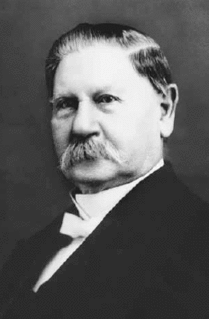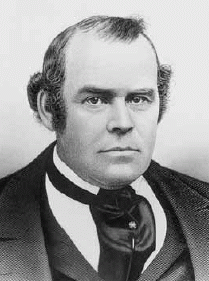Related Research Articles

Brigham Young was an American religious leader and politician. He was the second president of The Church of Jesus Christ of Latter-day Saints, from 1847 until his death in 1877. During his time as church president, Young led his followers, the Mormon pioneers, west from Nauvoo, Illinois to the Salt Lake Valley. He founded Salt Lake City and served as the first governor of the Utah Territory. Young also worked to establish the learning institutions which would later become the University of Utah and Brigham Young University. A polygamist, Young had at least 56 wives and 57 children. He instituted a ban prohibiting conferring the priesthood on men of black African descent, and led the church in the Utah War against the United States.

Polygamy was practiced by leaders of The Church of Jesus Christ of Latter-day Saints for more than half of the 19th century, and practiced publicly from 1852 to 1890 by between 20 and 30 percent of Latter-day Saint families. Today, various denominations of fundamentalist Mormonism continue to practice polygamy.
The Mountain Meadows Massacre was a series of attacks during the Utah War that resulted in the mass murder of at least 120 members of the Baker–Fancher emigrant wagon train. The massacre occurred in the southern Utah Territory at Mountain Meadows, and was perpetrated by the Mormon settlers belonging to the Utah Territorial Militia who recruited and were aided by some Southern Paiute Native Americans. The wagon train, made up mostly of families from Arkansas, was bound for California, traveling on the Old Spanish Trail that passed through the Territory.
Within Mormonism, the priesthood authority to act in God's name was said by its founder, Joseph Smith, to have been removed from the primitive Christian church through a Great Apostasy, which Mormons believe occurred due to the deaths of the original apostles. Mormons maintain that this apostasy was prophesied of within the Bible to occur prior to the Second Coming of Jesus and was therefore in keeping with God's plan for mankind. Smith claimed that the priesthood authority was restored to him from angelic beings—John the Baptist and the apostles Peter, James, and John.
The Utah War (1857–1858), also known as the Utah Expedition, Utah Campaign, Buchanan's Blunder, the Mormon War, or the Mormon Rebellion was an armed confrontation between Mormon settlers in the Utah Territory and the armed forces of the US government. The confrontation lasted from May 1857 to July 1858. There were some casualties, most of which were non-Mormon civilians. The war had no notable military battles.

John Williams Gunnison was an American military officer and explorer.

Charles William Penrose was a member of the Quorum of the Twelve Apostles of The Church of Jesus Christ of Latter-day Saints from 1904 to 1911. Penrose was also a member of the First Presidency, serving as a counselor to church presidents Joseph F. Smith and Heber J. Grant from 1911 until his death.

Parley Parker Pratt Sr. was an early leader of the Latter Day Saint movement whose writings became a significant early nineteenth-century exposition of the Latter Day Saint faith. Named in 1835 as one of the first members of the Quorum of the Twelve Apostles, Pratt was part of the Quorum's successful mission to Great Britain from 1839 to 1841. Pratt has been called "the Apostle Paul of Mormonism" for his promotion of distinctive Mormon doctrines.

Blood atonement is a disputed doctrine in the history of Mormonism, under which the atonement of Jesus does not redeem an eternal sin. To atone for an eternal sin, the sinner should be killed in a way that allows his blood to be shed upon the ground as a sacrificial offering, so he does not become a son of perdition. The largest Mormon denomination, The Church of Jesus Christ of Latter-day Saints, has denied the validity of the doctrine since 1889 with early church leaders referring to it as a "fiction" and later church leaders referring to it as a "theoretical principle" that had never been implemented in the LDS Church.

Brigham Young Jr. served as president of the Quorum of the Twelve Apostles of The Church of Jesus Christ of Latter-day Saints from 1899 until his death. His tenure was interrupted for one week in 1901 when Joseph F. Smith was the president of the Quorum.
The Mormon Reformation was a period of renewed emphasis on spirituality within The Church of Jesus Christ of Latter-day Saints, and a centrally-directed movement which called for a spiritual reawakening among church members. It took place during 1856 and 1857 and was under the direction of church president Brigham Young. During the Reformation, Young sent his counselor, Jedediah M. Grant, and other church leaders to preach to the people throughout Utah Territory and surrounding Latter-day Saint communities with the goal of inspiring them to reject sin and turn towards spiritual things. During this time, some of the most conservative or reactionary elements of LDS Church doctrine came to dominate public discussion. As part of the Reformation, almost all "active" or involved LDS Church members were rebaptized as a symbol of their commitment. The Reformation is considered as being split into three phases: a structural reform phase, a phase of intense demand for a demonstration of spiritual reform, and a final phase during which an emphasis was placed on love and reconstruction.
Chief Walkara was a Shoshone leader of the Utah Indians known as the Timpanogo and Sanpete Band. It is not completely clear what cultural group the Utah or Timpanogo Indians belonged to, but they are listed as Shoshone. He had a reputation as a diplomat, horseman and warrior, and a military leader of raiding parties, and in the Wakara War.

Joseph Angell Young was an apostle of The Church of Jesus Christ of Latter-day Saints. Young is one of the few Latter-day Saints in history to have been ordained to the office of apostle without ever becoming a member of the Quorum of the Twelve Apostles or the First Presidency.
Mormons have both used and been subjected to significant violence throughout much of the religion's history. In the early history of the United States, violence was used as a form of control. Mormons were violently persecuted and pushed from Ohio to Missouri, from Missouri to Illinois and from Illinois, they were pushed west to the Utah Territory. There were incidents of massacre, home burning and pillaging, followed by the death of their prophet, Joseph Smith. Smith died from multiple gunshot wounds from a lynch mob at a jail in Carthage, Illinois; Smith had defended himself with a small pistol smuggled to him by church leader Cyrus Wheelock and he was then shot while trying to flee from a window. There were also notable incidents in which Mormons perpetrated violence. Under the direction of Mormon prophets and apostles, the Mormon burned and looted Davies County, attacked and killed a member of the Missouri state militia, and carried out an extermination order on the Timpanogos. Other Mormon leaders led the Mountain Meadows Massacre, Battle Creek massacre, and Circleville Massacre. Mormons have also been a major part in several wars, including the 1838 Mormon War, Walker War and Black Hawk War.
Mormon theology has long been thought to be one of the causes of the Mountain Meadows Massacre. The victims of the massacre, known as the Baker–Fancher party, were passing through the Utah Territory to California in 1857. For the decade prior the emigrants' arrival, Utah Territory had existed as a theocracy led by Brigham Young. As part of Young's vision of a pre-millennial "Kingdom of God", Young established colonies along the California and Old Spanish Trails, where Mormon officials governed as leaders of church, state, and military. Two of the southernmost establishments were Parowan and Cedar City, led respectively by Stake Presidents William H. Dame and Isaac C. Haight. Haight and Dame were, in addition, the senior regional military leaders of the Mormon militia. During the period just before the massacre, known as the Mormon Reformation, Mormon teachings were dramatic and strident. The religion had undergone a period of intense persecution in the American mid-west.
Edward James Wood was a prominent local leader of The Church of Jesus Christ of Latter-day Saints in Alberta, Canada and was the founder of Glenwood, Alberta, and Hill Spring, Alberta.
The "Runaway Officials of 1851" were a group of three federal officers, Judge Perry Brocchus, Judge Lemuel Brandenbury, and Territorial Secretary Broughton Harris, who were appointed to Utah Territory by President Millard Fillmore in 1851. These men arrived in Utah in the summer of that year, and though they were cordially welcomed, they soon came into conflict with The Church of Jesus Christ of Latter-day Saints and Latter-day Saint settlers of the territory. The confrontation centered around several features of the Mormon pioneer community, most significantly their practice of polygamy, which the appointees publicly denigrated. Eventually disagreements over territorial administration became rampant between the non-Mormon federal officials and newly appointed territorial Governor and President of the LDS Church, Brigham Young. By the end of September 1851, each of these officers left his Utah appointment for the east and their posts remained unfilled for the next two years. This was the first in a series of disagreements between the Latter-day Saint residents of Utah Territory and the United States government which would finally result in the Utah War of 1857–1858.

Possibly as early as the 1830s, followers of the Latter Day Saint movement, were practicing the doctrine of polygamy or "plural marriage". After the death of church founder Joseph Smith, the doctrine was officially announced in Utah Territory in 1852 by Mormon leader Brigham Young. The practice was attributed posthumously to Smith and it began among Mormons at large, principally in Utah where The Church of Jesus Christ of Latter-day Saints had relocated after the Illinois Mormon War.
In 1857, at the time of the Mountain Meadows Massacre, Brigham Young, was serving as President of The Church of Jesus Christ of Latter-day Saints and as Governor of Utah Territory. He was replaced as governor the following year by Alfred Cumming. Evidence as to whether or not Young ordered the attack on the migrant column is conflicted. Historians still debate the autonomy and precise roles of local Cedar City LDS Church officials in ordering the massacre and Young's concealing of evidence in its aftermath. Young's use of inflammatory and violent language in response to a federal expedition to the territory added to the tense atmosphere at the time of the attack. After the massacre, Young stated in public forums that God had taken vengeance on the Baker–Fancher party. It is unclear whether Young held this view because of a possible belief that this specific group posed a threat to colonists or that they were responsible for past crimes against Mormons. According to historian William P. MacKinnon, "After the war, Buchanan implied that face-to-face communications with Brigham Young might have averted the Utah War, and Young argued that a north–south telegraph line in Utah could have prevented the Mountain Meadows Massacre."
John Lyman Smith was an American politician and Mormon missionary. He served as a member of the Utah Territory's Legislative Assembly's House of Representatives for Iron County, Utah, from 1852 to 1853, and the Great Salt Lake County, Utah, from 1853 to 1855. Cousin of the founder of the Latter Day Saint Movement, Joseph Smith, Smith was a member of The Church of Jesus Christ of Latter-day Saints who traveled to the Salt Lake Valley with his family and other Mormon pioneers in 1846. His father John Smith served as the fourth Presiding Patriarch for the LDS Church from 1847 to 1854. Additionally, he served two missions as the mission president for the LDS Church in Switzerland and Italy from May 1855 to June 1858 and September 1860 to December 1863. After his missions, he served in various civic and ecclesiastical positions in Utah.
References
- 1 2 3 4 5 6 7 "Drunk, Disgrace, Death", Chicago Inter Ocean (November 21, 1888), p. 1.
- 1 2 "Another Chapter", Chicago Inter Ocean (November 23, 1888), p. 7.
- ↑ "From Utah", The Triweekly Washington Sentinel (September 11, 1855), p. 2.
- 1 2 3 Michael W. Homer, "The Judiciary and the Common Law in Utah Territory, 1850-61", Dialogue: A Journal of Mormon Thought (Spring 1988), Col. 21, No. 1, p. 104.
- ↑ "Mormonism as Revealed by the Chief Justice of Utah", The Summit County Beacon (April 29, 1857), p. 1.
- ↑ "Neighboring Items", The Macomb Journal (December 6, 1888), p. 1.